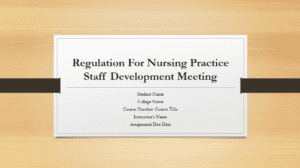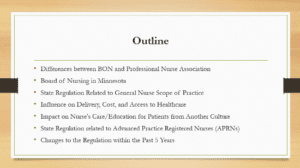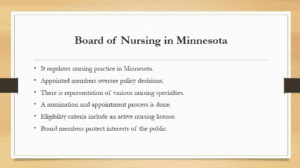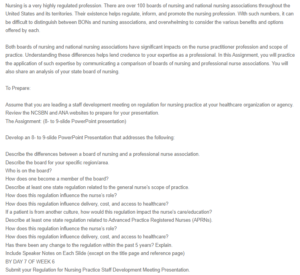We’ll write everything from scratch Question Nursing is a very highly regulated profession. There are over 100 boards of nursing and national nursing associations throughout the United States and its territories. Their existence helps regulate, inform, and promote the nursing profession. With such numbers, it can be difficult to distinguish between BONs and nursing associations, and overwhelming to consider the various benefits and options offered by each. Regulation For Nursing Practice Staff Development Meeting Both boards of nursing and national nursing associations have significant impacts on the nurse practitioner profession and scope of practice. Understanding these differences helps lend credence to your expertise as a professional. In this Assignment, you will practice the application of such expertise by communicating a comparison of boards of nursing and professional nurse associations. You will also share an analysis of your state board of nursing. To Prepare: Assum
Regulation For Nursing Practice Staff Development Meeting

Hello, and welcome to this presentation on Regulation for Nursing Practice Staff Development Meeting.

The presentation begins by highlighting the differences between the Board of Nursing (BON) and the Professional Nurse Association. It then focuses on the Board of Nursing in Minnesota, emphasizing its role in regulating nursing practice. Next, we will discuss the state regulation that defines the scope of practice for general nurses and its impact on healthcare delivery, cost, and access. We will further explore the influence of regulations on nurses’ care and education for patients from different cultures, emphasizing the importance of cultural competence. Lastly, the presentation covers the state regulation pertaining to Advanced Practice Registered Nurses (APRNs), including any recent changes made to the regulation.

A Board of Nursing is a regulatory body established by a state to oversee and implement nursing practice standards. Its main duty is to protect the public by ensuring that nurses meet the required qualifications, follow ethical guidelines, and maintain competency in their practice (Walton et al., 2020). The board grants nursing licenses, conducts disciplinary actions, and develops and administers licensing exams. Its role is primarily in the regulation and enforcement of nursing practice. On the other hand, a Professional Nurse Association is a voluntary organization composed of nurses. It aims to promote the interests and welfare of its members. It provides a platform for networking, professional development, and advocacy. Professional associations offer resources, educational opportunities, and support to nurses. They nurture professional growth and enhance the quality of nursing practice. They advocate for nurses’ rights, address policy issues, and promote progress in the field. While they may collaborate with regulatory bodies, their main role is representing and supporting the professional needs of nurses.

The Board of Nursing for Minnesota is the regulatory body responsible for the supervision of nursing practice in the state. The board consists of members appointed by the Governor. They include registered nurses, licensed practical nurses, and public members. The board is composed of nurses from different specialties and settings. This ensures a diverse representation. To become a member of the board, interested individuals go through a nomination and appointment process. The Governor’s office asks for applications from qualified individuals who meet the eligibility criteria. These criteria may include ownership of an active nursing license, having a certain number of years of nursing experience, and demonstration of commitment to public service. The selection process may involve reviewing applications, conducting interviews, and evaluating candidates’ qualifications and skills. Once selected, board members serve for a set duration. During this period, they fulfill their responsibilities. This consists of making policy decisions, implementing regulations, and protecting the public’s interest in nursing practice in Minnesota.

In Minnesota, a specific state regulation is the Minnesota Nurse Practice Act. This regulation outlines the legal boundaries within which nurses can practice and their responsibilities. According to the act, general nurses are allowed to provide direct patient care. This consists of assessment, planning, intervention, and evaluation of nursing care. They are allowed to administer medications, perform procedures, and work with other healthcare providers. However, there are limitations in their scope of practice. For instance, there are restrictions on prescribing medications and making medical diagnoses. The regulation has a significant influence on the nurse’s role. It sets clear guidelines for their practice and ensures patient safety. It establishes professional standards, ethical principles, and quality care expectations. The act also outlines the legal duties of nurses. The regulation directly impacts patient care and outcomes. It promotes safe and competent nursing practices. It helps ensure that patients receive appropriate and evidence-ba
